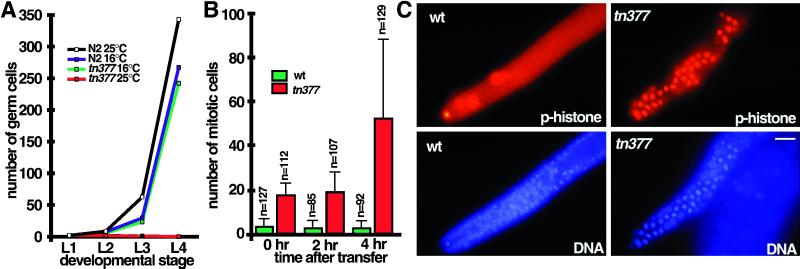Figure 4.
emb-30 is required for germline proliferation. (A) Time course and temperature sensitivity of germline proliferation in emb-30(tn377ts) compared with the wild type. Larvae were synchronized by collecting L1-stage animals that hatched during a 1-h period. Germ cell number per gonad (L1 and L2) or per gonad arm (L3 and L4) was determined at 16 and 25°C. After transfer of gastrula-stage embryos to 25°C, Z2 and Z3 block in mitosis of their first division during the L1 stage; thus, at most, two germ cells are observed. At the L4 stage, germ cells were often absent (0.2 ± 0.5 germ cells per gonad arm; n = 22 gonad arms scored). For the L3 time point, the larvae in the wild-type 25°C sample were at a developmentally later stage (late L3), accounting for the slight increase in germ cell number compared with the 16°C samples. (B and C) Mitotic germ cell accumulation in the distal zone of the emb-30(tn377ts) adult hermaphrodite gonad. emb-30(tn377ts) and wild-type hermaphrodites were grown at 16°C and shifted to 25°C as young adults (92 h after hatch at 16°C). Quantitation of mitotic nuclei (mean ± SD; n = number of gonad arms scored at each time point) is shown in B, and representative phosphohistone H3 and DAPI immunofluorescence images from the 4-h time point are shown in C. Bar, 10 μm.

